Abstract
Previously conducted studies have established that the sudden collapse of large areas of overhanging roofs in longwall working faces can cause shock loads and wind blast. In order to solve the problem of the hard and stable roof (HSR) being difficult to collapse in the initial mining stage, a combination of theoretical analysis and numerical simulation is used, taking Dongqu coal mine as the engineering background. The mechanical model of the initial fracture of the main roof is established, the relationship between the thickness-to-span ratio of main roof, the internal stress of the roof is analyzed, and the relationship between the thickness of the roof and the initial weighting step is revealed. The method of hydraulic fracturing (HF) is proposed to pre-crack the main roof in order to achieve controllability of the roof. The effect of HF on the control of the HSR is analyzed. The main conclusions are as follows: under the condition of a certain span of the rock beam, a smaller thickness of the rock beam makes for a larger tensile stress inside of it, increasing the likelihood that the rock beam will fracture. It is possible to reduce the initial weighting interval of the main roof by decreasing the thickness of the HSR and increasing the thickness of the load layer. The abutment pressure in the initial mining stage is obviously reduced after HF. The technical scheme of HF was proposed and applied in the field, and the field observations show that after HF, the HSR can collapse in time at the initial mining stage, leading to remarkable results being achieved.
1. Introduction
The coal seam assignment conditions in China are complex, and the situation of a hard roof above the coal seam that is difficult to collapse is common. In this scenario, more than 40% of the roof of the fully mechanized working face belongs to the HSR, with strong rock pressure [1,2]. After coal seam mining, the HSR is exposed to the goaf in a large area, especially in the initial mining stage. When a large area of caving occurs, there is strong rock failure and obvious dynamic phenomena [3], causing damage to support equipment, face spall [4], and even accidents that can endanger personal safety [5].
In order to guarantee the safe production of the working face during initial mining, scholars have carried out a great deal of research on the problem of HSR situations are difficult to collapse. Bai et al. [6] revealed that the treatment of the HSR resulted in lower stress concentrations and less roadway deformation, making safe mining of small coal pillars possible. Wang et al. [7] proposed the use of deep hole pre-cracking blasting technology to solve the problem of large thickness and high strength of the main roof causing large incoming pressure. In order to solve the problems involving a large overhanging roof and strong mine pressure behavior, Chen et al. [8,9] established a fracture model of HSR and put forward a deep hole pre-cracking blasting technique. Wang et al. [10] analyzed the distribution rules and ground pressure behavior characteristics of HSR, and developed blasting control techniques for weakening the roof. Hu et al. [11] proposed the use of deep hole loosening blasting to solve the problem of a difficult to collapse hard and thick sandstone roof. Ma et al. [12] introduced the use of directional presplit cumulative blasting technology to control composite HSR.
However, there are many problems with traditional blasting forced caving technology, such as larger quantities of explosives, higher costs [13], pollution of underground air, and more. In addition, in gas mines blasting is not allowed for forced caving due to the danger of gas explosion [14]. There is a need for a practical and efficient method to control and pre-crack the main roof in order to facilitate its collapse. The use of hydraulic fracturing technology is a very good way to accelerate the large-scale caving of the roof in longwall goaf [15]. In comparison with the utilization of pre-fracture blasting techniques to control HSR, HF has the advantages of high security, easy operation, and low cost [16]. Lekontsev et al. [17] suggested a directional HF control technique for the control of HSR in coal mines. Huang et al. [18,19,20] concluded that HF can modify the structure of the coal and rock mass and weaken its strength, which can be applied for HSR and coal control; in addition, they combined the advantages of hydraulic slitting and HF, and proposed a directional fracturing technique. Cheng et al. [21] put forward a method for weakening hard rock masses by HF through a combination of pre-pulsing and a constant pumping rate. Xia et al. [22] analyzed the hydraulic fracture expansion law of HSR in mining sites, providing a theoretical basis for the application of HF in the weakening of HSR. Lu et al. [23] raised the use of a surface HF technique for far-field HSR control under the condition of extra-thick coal seam mining, and identified the key seam locations. Through a series of numerical simulations of HF, Chen et al. [24] found that the HF operation was more effective in the area near the middle of the gob. Puller et al. [25] proposed the use of hydraulic fracturing to prevent windblast and periodic caving hazards associated with conglomerate strata.
Although there are many studies on control of HSR, a great deal of work needs to be done on the difficult collapse of HSR in the initial mining stage of the working face. Obviously, HF is an effective method. However, there are few studies on the mechanism of HF to control HSR. The main roof of working face 18,311 in Dongqu Coal Mine is a thick and hard limestone layer. When no forced caving measures are taken, the first caving interval can reach 40 m. In order to prevent threats to the safe production of the working face caused by the collapse of a large area of the roof during initial mining, this paper studies the stress distribution law inside the main roof before its fracture and analyzes the factors affecting the first fracture step of the main by establishing a mechanical model. Based on this, it is proposed to artificially separate rock layers by HF, thereby reducing the thickness of the main roof and increasing the thickness of the load layer, in order to reduce the first caving interval and realize the controllability of the roof. The effect of HF on the control of HSR was analyzed by numerical simulation. Finally, the technical plan of HF was proposed and applied in the field. It can be seen from the field observation that the HSR can collapse in time after fracturing. Our research results provide a theoretical basis for controlling the HSR at the initial mining stage of the working face.
2. Geological Conditions of the Working Face
This paper takes the 18,311 panel of Dongqu coal mine as an engineering example to carry out research on HSR control by HF in the initial mining stage. As shown in Figure 1, to the north of the 18,311 panel is the 18,309 panel, which has been mined, to the west is the main roadway, and to the south is the 18,313 panel. This face is approximately 177 to 285 m. As the figure shows, the working face has no immediate roof and the roof layers are very thick. The roof rock consists of limestone, which has high strength.
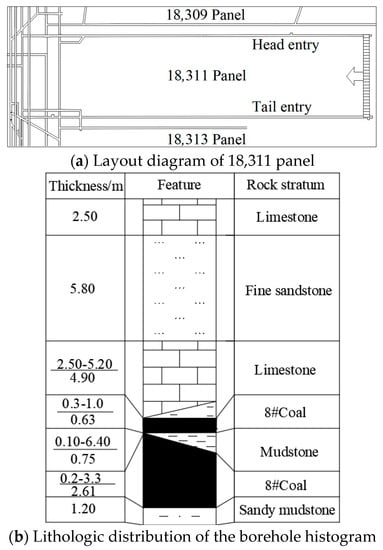
Figure 1.
Layout and roof lithology of 18,311 panel.
3. HF Control Ideas for HSR
3.1. Basic Principles of HF for Controlling HSR
As the length of the working face along the inclined direction is much larger than the span of the main roof along the strike, the main roof can be regarded as a fixed beam with one end supported by the coal body of the working face and the other supported by the boundary coal pillar, i.e., the so-called ‘beam’ hypothesis. At this time, if the strength of the strata above the main roof is low, the weight of the overlying strata is transferred to the supporting points at both ends through the ‘beam’ of the main roof, that is, the coal body and the coal pillar. During the initial mining period of the working face, the overhanging distance of the main roof gradually increases as the working face continues to advance and fractures when it reaches its limit span [26,27]. Until the main roof fractures, the roof is supported by the coal body on the side of the working face and setup entry [28]; as such; it can be regarded as a beam fixed at both ends. The mechanical model is shown in Figure 2.
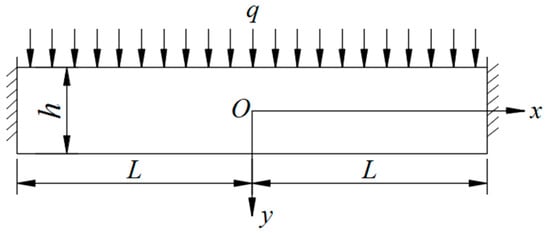
Figure 2.
Mechanical model.
From the theory of elasticity [29], the expression for the stress at any point in a solid support beam is
where σx, σy, τxy are the horizontal, vertical, and shear stresses, respectively, at any point inside the rock beam; q is the uniform load stress at the top of the rock beam, MPa; h is the thickness of the rock beam, m; L is 1/2 of the span of the rock beam, m; v is the Poisson’s ratio of the rock beam; and x, y are the coordinate values of any point inside the solid support beam.
Rock beams are susceptible to tensile or shear damage, with the specific form of damage being determined by the internal stress state and the tensile and shear strength. The form and location of fracture and crack extension at the beginning of the rock beam can be further investigated by analyzing the distribution of the maximum principal stress and maximum shear stress inside the rock beam. The relationship between the maximum principal stress and the maximum shear stress, along with the stress components, is [30]
From Equations (1)–(3), the maximum principal stress σ1 and the maximum shear stress τmax can be obtained at any point on the solid rock beam; it can be seen that the load q on the main roof does not affect the distribution characteristics of σ1 and τmax, only their numerical magnitude. Moreover, the distribution law of σ1 and τmax is related to the thickness and span of the main roof. The overlying load q is 0.5 MPa, the Poisson’s ratio of the main roof v is 0.25, and the thickness of the main roof h is 5 m. The thickness-to-span ratio n (n = h/2L) is taken as 0.25, 0.5, 0.75, 1 for four cases, and the distribution law of the maximum principal stress and maximum shear stress inside rock beam are shown in Figure 2 and Figure 3.


Figure 3.
Maximum principal stress distribution diagram of fixed-supported rock beam with different thickness–span ratios.
From Figure 3 and Figure 4, it can be seen that the ratio of thickness to span n gradually decreases with the increase in advancing distance, and the maximum principal stress (tensile stress) and shear stress inside the fixed-supported rock beam gradually become larger. Under the action of the overlying uniform load, the maximum principal stress σ1 is mainly concentrated at the top of the beam at both ends, and is tensile stress, while the maximum principal stress at both ends gradually decreases to zero from the top to the bottom. The maximum shear stress τmax first appears at the top of the beam at both ends, then appears at the top and bottom of the beam as the thickness-to-span ratio n decreases. When the tensile stress inside the rock beam is greater than its own tensile strength, the rock beam fractures; therefore, under the condition of a certain span of the rock beam, a smaller thickness of the rock beam makes for greater tensile stress inside it, increasing the likelihood that the rock beam will fracture.
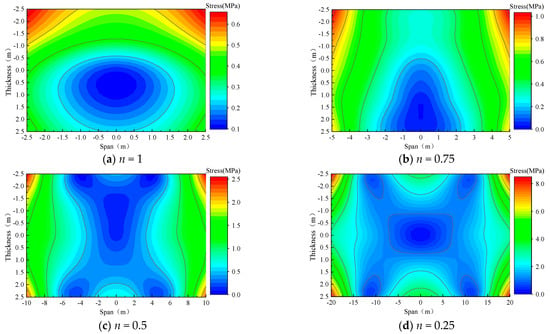
Figure 4.
Maximum shear stress distribution diagram of fixed-supported rock beam with different thickness–span ratios.
From the above analysis of the distribution law of σ1 and τmax, it is known that the maximum principal stress σ1 at the top of both ends of the main roof is tensile stress, which makes it easy to produce tensile damage as the advancing distance increases. The concentrated high stress at the end expands downward from the top, and the support condition of the main roof rock beam changes from fixed support to simple support during crack propagation. It is known that according to the calculation of a simply supported beam, the main roof of the initial fracture step L is
where h is the thickness of the main roof, h1 is the thickness of the load layer acting on the main roof, Rt is the tensile strength of the main roof, and γ is the capacitive weight of the rock layer.
To illustrate the mechanism of dealing with HSR, Equation (4) is calculated by taking Rt = 7.5 MPa and γ = 0.025 MN/m3. Let h1 = 20 m and calculate the initial incoming pressure step L for different thickness of main roof; then, let h = 10 m and calculate the step L for different thicknesses of the load layer. The calculation results for the two cases produce the curves shown in Figure 5.
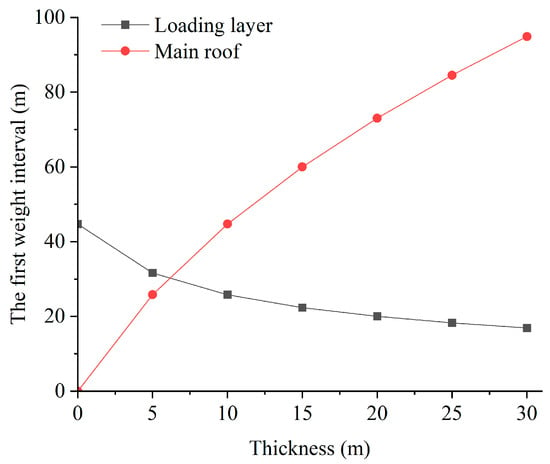
Figure 5.
The relationship between the first weighting interval of the main roof L, along with its height h and load strata h1.
The above results show that the initial weighting step of the main roof can be reduced by reducing the thickness of the HSR and increasing the thickness of the load layer. In this way, it reduces the load of the support and fully ensures the safe production of the working face.
3.2. Control Method for HF
Based on the above analysis, it is possible to reduce the thickness of the main roof and increase the thickness of the load layer by segmental hydraulic fracturing technology to realize the timely collapse of the roof. In addition, the stress concentration of the coal body in front of the workings decreases with the increase in the rock pack thickness value [31]. During the initial mining of the working face, in order to prevent the danger caused by large-scale caving of the HSR, the number of cracks in the HSR is artificially increased by HF and a hydraulic fracture network is formed to destroy its integrity, thereby changing the fracture characteristics of the HSR and increasing the rock pack thickness. As shown in Figure 6, in order to prompt the HSR to cave in time, HF is carried out on the roof above and ahead of the setup entry. At the same time, in order to cut the two ends of the HSR, HF is carried out in the tail entry and head entry. The area represented by the red dotted line is the fracturing area.
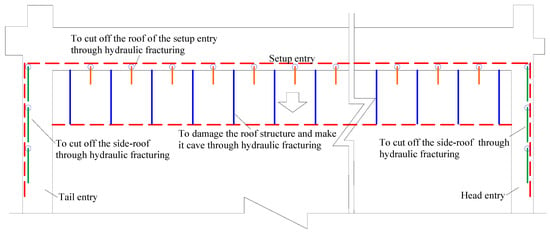
Figure 6.
The control method of HSR by HF.
4. Numerical Simulation Study of the Control Effect of HF
4.1. Establishment of the Model
According to the geological conditions of working face 18,311 in Dongqu Coal Mine, a numerical calculation model was established using UDEC 6.0 software to further study the control effect of HF. The width of the model was 150 m, and the height is 50 m, a vertical stress of 5.3 Mpa was applied at the top of the model, the horizontal displacement was fixed at the left and right boundary of the model, and the bottom boundary was fixed. The Mohr–Coulomb elastic–plastic constitutive model was selected for the block, and the surface contact Coulomb slip model was used for the contact surface of the model. The model excavated the No. 8 coal seam from the location of the setup entry; the excavation step was determined to be 5 m according to the daily cycle feed of this working face. The model is shown in Figure 7, and the physical and mechanical parameters of the coal and rock mass are shown in Table 1.
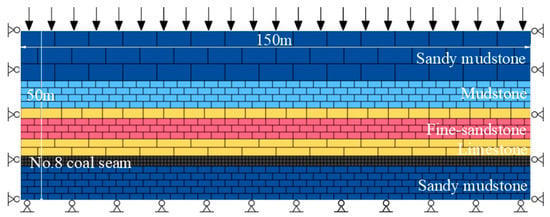
Figure 7.
Numerical calculation model.

Table 1.
Physical and mechanical parameters of the coal and rock mass.
4.2. Scheme of Numerical Simulation
The hydraulic fractures generated at the roof after HF were simulated by pre-designing cracks in the roof above the working face in the model. The roof caving law and the distribution law of advanced abutment pressure of the working face before and after HF were compared and analyzed, then the control effect of HF in the initial mining stage of the working face was studied. From the above theoretical analysis, it is clear that the thickness of the main roof and load layer is an important factor affecting the initial fracture step. Therefore, the effect of hydraulic fracturing on the control of the initial fracture step was simulated for four cases of fracture height: 0 m (unfractured), 5 m, 10 m, and 15 m, as shown in Figure 8.
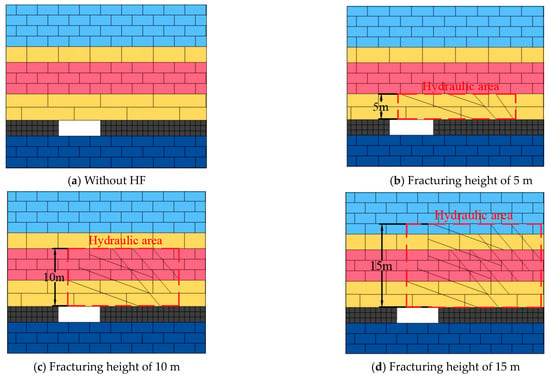
Figure 8.
The hydraulic fracturing scheme.
4.3. Analysis of Numerical Simulation Results
4.3.1. Roof Activity Law in Initial Mining Stage of the Working Face
Figure 9 shows the collapse of the roof in the initial mining stage of the working face with different fracture heights. As can be seen from the figure, when the working face without fracture advances to 40 m, initial fracture of the main roof occurs. The central roof is in contact with the floor due to the hardness and integrity of the roof, and the two ends are supported by the coal rib to form a hanging roof of about 16 m. When the fracture height is 5 m, the initial fracture interval of the main roof is reduced to 35 m, and there are 15 m and 10 m of overhanging roofs behind the working face and at the back of the gob, respectively. When the fracture height is 10 m, the initial fracture step of the main roof is reduced to 25 m, the roof behind the gob collapses, and there is about 10 m of overhanging roof behind the working face. When the fracture height is 15 m, the initial fracture step is reduced to 15 m and there is no overhanging roof formed at either end of the roof.
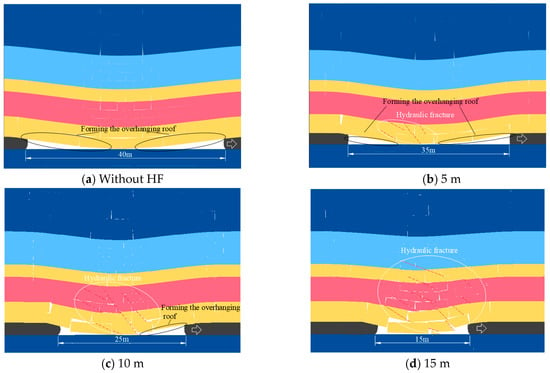
Figure 9.
The collapse of the roof at different fracturing heights during the initial mining stage.
4.3.2. Distribution Law of Front Abutment Pressure in Initial Mining Stage of the Working Face
Figure 10 shows the distribution pattern of front abutment pressure during the initial weighting of the working face at different fracturing heights. It can be seen from the figure that HF has a significant impact on the front abutment pressure in the initial mining stage of the working face. When HF is not considered, the peak pressure at the working face during the initial weighting reaches 21.8 MPa, and the stress concentration factor is 3.48. With increasing fracture height, the peak pressure gradually decreases; when the fracture height is 15 m, the peak pressure decreases to 14.1 MPa, a reduction of 35.3%. The numerical results suggest that HF reduces both the abutment stresses and the peak stresses.
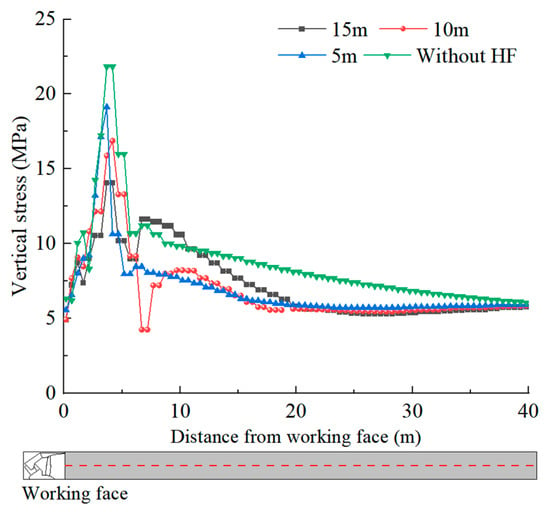
Figure 10.
Effect of HF on front abutment stresses within the pillar.
In order to further analyze the variation of abutment pressure under the conditions of different fracturing heights, a stress monitoring line is set in the coal body behind the goaf. Figure 11 compares and analyzes the distribution rule of abutment pressure behind the gob in the initial mining stage of the working face before and after fracturing. From the figure, it can be seen that HF has a significant effect on the abutment pressure at the back of the gob during the initial mining phase of the working face. When HF is not considered, the peak pressure at the back of the gob increases continuously as the working face advances to 40 m. When the working face advances to 40 m, the abutment pressure reaches 17.9 MPa. After HF is applied to the roof, the peak pressure at the back of the mining area decreases significantly, and when the fracturing height is 15 m, the peak pressure decreases to 11.8 MPa, a reduction of 34.1%.
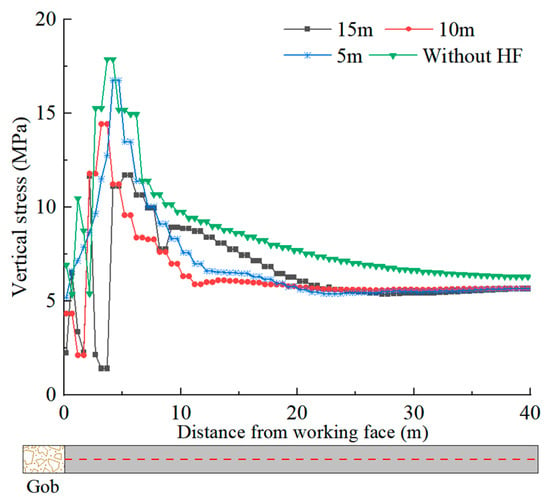
Figure 11.
Effect of HF on back abutment stresses within the pillar.
5. Field Application
5.1. Technical Solution for HF
The HF plan is shown in Figure 12, in which HF is carried out in the entire setup entry and two roadways. Fifteen groups of boreholes are arranged in the setup entry, with each group including two boreholes in a three-flower arrangement. Drill hole A is arranged perpendicular to the coal rib and has an elevation angle of 70°. Drill hole B is arranged perpendicular to the coal rib as well, with an elevation angle of 40°. Six boreholes are arranged in the two roadways, and Borehole C is constructed diagonally upwards in the direction of the working face advancement at an elevation angle of 54°.
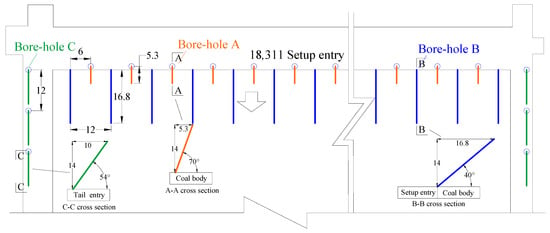
Figure 12.
HF borehole arrangement. (A is the section of borehole A, B is the section of borehole B and C is the section of borehole C).
5.2. The Construction Process of HF
The HF construction site is shown in Figure 13. As can be seen in the figure, there is a wide range of water dripping from the adjacent borehole and the gap of the supports during the HF. This indicates that the water has caused cracks in the roof and penetrated due to the adjacent borehole.
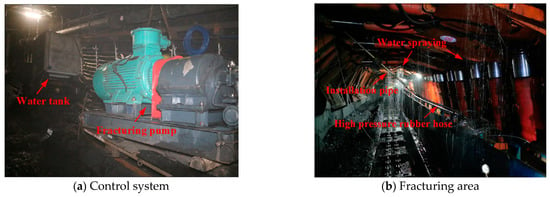
Figure 13.
HF construction site.
The pressure change curve of the water during the fracturing process is shown in Figure 14. It can be seen from the graph that the water pressure in the 40° borehole fluctuates and increases. The maximum pressure reached is 44 MPa, and the minimum pressure is 30 MPa. The pressure variation in the 70° borehole shows a trend of first decreasing and then increasing. The pressure decreases to a minimum of 30 MPa at 36 m and 72 m, and reaches a maximum of 44 MPa at 156 m.

Figure 14.
The pressure variation curve of HF at working face 18,311.
5.3. Analysis of the Effect of HF
After taking HF measures at working face 18,311, the collapse of the roof during the advance of the working face was observed; the observation results are shown in Table 2. When the working face was advanced 3 m, the roof of the two ends of the gob had collapsed. When the working face was advanced by 6 m, the roof in the back of 40#~79# supports collapsed, and the range reached 66.3 m. When the working face was advanced 12 m, the roof in the back of 19#~97# supports collapsed, and the range reached 132.6 m. When the working face was advanced 15 m, the roof collapsed completely.

Table 2.
Roof caving in gob after HF in working face 18,311.
Compared with no HF measures, the initial collapse step of the working face was reduced from about 40 m to 16 m, a reduction of 60.0%, and the fracturing effect was very significant. The collapse pattern of the roof changed from the conventional whole fracture to multiple fractures in segments, and the degree of ground pressure during the initial fracture became moderate.
6. Conclusions
- As the thickness to span ratio n gradually decreases, the maximum principal stress and shear stress of the solid-supported rock beam gradually increase. The maximum principal stress σ1 is mainly concentrated at the top of the beam at both ends, and is tensile stress, while the maximum principal stress at both ends gradually decreases to zero from the top to the bottom. When the tensile stress inside the rock beam is greater than its own tensile strength, the rock beam fractures.
- The thickness of the HSR can be reduced by artificially separating rock layers through HF, increasing the thickness of the load layer acting on the main roof rock layer and reducing the initial weighting interval of the main roof in order to reduce the load on the support, thereby ensuring the safe production of the working face.
- Our numerical results show that the initial caving step of the working face was reduced by 15 m, with a decrease of 62.5% following HF. The maximum peak value of the front abutment pressure was reduced from 21.8 MPa to 14.1 MPa, a reduction of 35.3%. The maximum peak value of the back abutment pressure was reduced from 17.9 MPa to 11.8 MPa, a decrease of 34.1%
- After taking HF measures, the initial collapse step of the working face was reduced from about 40 m to 16 m, a reduction of 60.0%, which is a remarkable effect.
Author Contributions
Investigation, H.Z., Z.C., K.Z. and H.L.; Data curation, X.Y.; Writing—original draft, H.Z.; Writing—review & editing, H.Z.; Supervision, C.L. All authors have read and agreed to the published version of the manuscript.
Funding
This work was supported by the National Natural Science Foundation of China (No. 52074267). The authors gratefully acknowledge this financial support.
Conflicts of Interest
The authors declare no conflict of interest.
References
- Mondal, D.; Roy, P.N.S.; Kumar, M. Monitoring the strata behavior in the destressed zone of a shallow indian longwall panel with hard sandstone cover using mine-microseismicity and borehole televiewer data. Eng. Geol. 2020, 271, 105593. [Google Scholar] [CrossRef]
- Pan, W.D.; Nie, X.D.; Li, X.Y. Effect of premining on hard roof distress behavior: A case study. Rock Mech. Rock Eng. 2019, 52, 1871–1885. [Google Scholar] [CrossRef]
- Shavarskyi, I.; Falshtynskyi, V.; Dychkovskyi, R. Management of the longwall face advance on the stress-strain state of rock mass. Min. Miner. Depos. 2022, 16, 78–85. [Google Scholar] [CrossRef]
- Yan, H.; Zhang, J.X.; Feng, R.M. Surrounding rock failure analysis of retreating roadways and the control technique for extra-thick coal seams under fully-mechanized top caving and intensive mining conditions: A case study. Tunn. Undergr. Sp. Technol. 2020, 97, 103241. [Google Scholar] [CrossRef]
- Vu, T.T. Solutions to prevent face spall and roof falling in fully mechanized longwall at underground mines, Vietnam. Min. Miner. Depos. 2022, 16, 127–134. [Google Scholar] [CrossRef]
- Bai, Q.S.; Tu, S.H.; Wang, F.T. Field and numerical investigations of gateroad system failure induced by hard roofs in a longwall top coal caving face. Int. J. Coal Geol. 2017, 173, 176–199. [Google Scholar] [CrossRef]
- Wang, F.T.; Tu, S.H.; Yuan, Y. Deep-hole pre-split blasting mechanism and its application for controlled roof caving in shallow depth seams. Int. J. Rock Mech. Min. 2013, 64, 112–121. [Google Scholar] [CrossRef]
- Chen, B.B.; Liu, C.Y.; Wang, B. A case study of the periodic fracture control of a thick- hard roof based on deep-hole pre-splitting blasting. Energy Explor. Exploit. 2022, 40, 270–301. [Google Scholar] [CrossRef]
- Chen, B.B.; Liu, C.Y. Analysis and application on controlling thick hard roof caving with deep-hole position presplitting blasting. Adv. Civ. Eng. Mater. 2018, 2018, 9763137. [Google Scholar] [CrossRef]
- Wang, J.W. Research on the control technology of heavy layer hard roof blasting. IOP Conf. Ser. Earth Environ. Sci. 2019, 358, 042017. [Google Scholar] [CrossRef]
- Hu, C.W.; Wang, E.Y.; Li, Q. Research on the key technology of gob-side entry retaining by roof cutting for thick and hard sandstone roofs. Sustainability 2022, 14, 9941. [Google Scholar] [CrossRef]
- Ma, Z.M.; Wang, J.; He, M.C. Key technologies and application test of an innovative non-coal pillar mining approach: A case study. Energies 2018, 11, 2853. [Google Scholar] [CrossRef]
- Vennes, I.; Mitri, H.; Chinnasane, D.R. Large-scale destress blasting for seismicity control in hard rock mines: A case study. Int. J. Min. Sci. Technol. 2020, 30, 141–149. [Google Scholar] [CrossRef]
- Huang, B.X.; Wang, Y.Z. Roof weakening of hydraulic fracturing for control of hanging roof in the face end of high gassy coal longwall mining: A case study. Arch. Min. Sci. 2016, 61, 601–615. [Google Scholar] [CrossRef]
- Matsui, K.; Shimada, H.; Anzwar, H. Acceleration of massive roof caving in a longwall gob using a hydraulic fracturing. In Proceedings of the ’99 International Symposium on Mining Science and Technology, Beijing, China, 29–31 August 2002; pp. 43–46. [Google Scholar]
- Yardimci, A.G.; Karakus, M. A new protective destressing technique in underground hard coal mining. Int. J. Rock Mech. Min. Sci. 2020, 130, 104327. [Google Scholar] [CrossRef]
- Lekontsev, Y.M.; Sazhin, P.V. Directional hydraulic fracturing in difficult caving roof control and coal degassing. Min. Sci. 2014, 50, 914–917. [Google Scholar] [CrossRef]
- Huang, B.X.; Zhao, X.L.; Chen, S.L. Theory and technology of controlling hard roof with hydraulic fracturing in underground mining. Chin. J. Rock Mech. Eng. 2017, 36, 2954–2970. [Google Scholar]
- Huang, B.X.; Yu, B.; Feng, F. Field investigation into directional hydraulic fracturing for hard roof in Tashan Coal Mine. J. Coal Sci. Eng. 2013, 19, 153–159. [Google Scholar] [CrossRef]
- Huang, B.X.; Wang, Y.Z.; Cao, S.G. Cavability control by hydraulic fracturing for top coal caving in hard thick coal seams. Int. J. Rock. Mech. Min. 2015, 74, 45–47. [Google Scholar] [CrossRef]
- Cheng, Q.Y.; Huang, B.X.; Shao, L.Y. Combination of pre-pulse and constant pumping rate hydraulic fracturing for weakening hard coal and rock mass. Energies 2020, 13, 5534. [Google Scholar] [CrossRef]
- Xia, B.W.; Zhang, X.; Yu, B. Weakening effects of hydraulic fracture in hard roof under the influence of stress arch. Int. J. Min. Sci. Technol. 2018, 28, 951–958. [Google Scholar] [CrossRef]
- Lu, Y.Y.; Gong, T.; Xia, B.W. Target stratum determination of surface hydraulic fracturing for far-field hard roof control in underground extra-thick coal extraction: A case study. Rock Mech. Rock Eng. 2019, 52, 2725–2740. [Google Scholar] [CrossRef]
- Chen, J.C.; Qu, Z.Z.; Zhou, L. Numerical sudy on the hydraulic fracturing fattern in the hard roof in response to mining-induced stress. Minerals 2023, 13, 308. [Google Scholar] [CrossRef]
- Puller, J.W.; Mills, K.W.; Jeffrey, R.G. In-situ stress measurements and stress change monitoring to monitor overburden caving behavior and hydraulic fracture pre-conditioning. Int. J. Min. Sci. Technol. 2016, 26, 103–110. [Google Scholar] [CrossRef]
- Zhang, H.L.; Xue, Y.L.; Li, Y.G. Study on initial fracture characteristics of the main roof in fully mechanized caving mining of inclined coalbed. Sustainability 2022, 14, 13782. [Google Scholar] [CrossRef]
- Ju, J.F.; Xu, J.L. Surface stepped subsidence related to top-coal caving longwall mining of extremely thick coal seam under shallow cover. Int. J. Rock Mech. Min. 2015, 78, 27–35. [Google Scholar] [CrossRef]
- Wang, J.C.; Wang, Z.H. Stability of main roof structure during the first weighting in shallow high-intensity mining face with thin bedrock. J. Min. Saf. Eng. 2015, 32, 175–181. [Google Scholar]
- Zhao, Y.X.; Wang, X.Z.; Zhou, J.L. Influence of main roof thickness-span ratio on the initial cracking induced instability in fully mechanized longwall face. J. China Coal Soc. 2019, 44, 94–104. [Google Scholar]
- Huang, Z.Z.; Gao, X.J.; Yuan, W.M. Stress distribution of cutting roof with deep borehole blasting for gob-side entry retaining techonolgy. Int. J. Coal Sci. Technol. 2022, 50, 88–96. [Google Scholar]
- Smoliński, A.; Malashkevych, D.; Petlovanyi, M. Research into Impact of Leaving Waste Rocks in the Mined-Out Space on the Geomechanical State of the Rock Mass Surrounding the Longwall Face. Energies 2022, 15, 9522. [Google Scholar] [CrossRef]
Disclaimer/Publisher’s Note: The statements, opinions and data contained in all publications are solely those of the individual author(s) and contributor(s) and not of MDPI and/or the editor(s). MDPI and/or the editor(s) disclaim responsibility for any injury to people or property resulting from any ideas, methods, instructions or products referred to in the content. |
© 2023 by the authors. Licensee MDPI, Basel, Switzerland. This article is an open access article distributed under the terms and conditions of the Creative Commons Attribution (CC BY) license (https://creativecommons.org/licenses/by/4.0/).